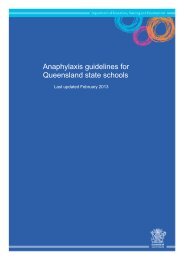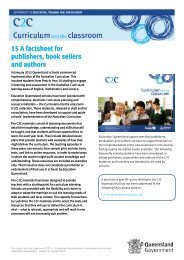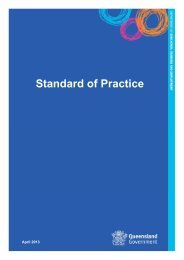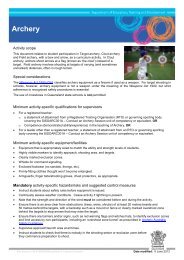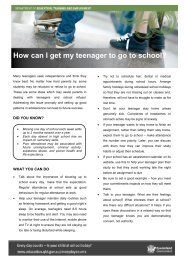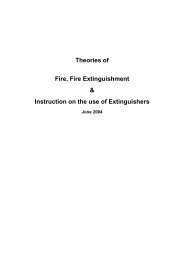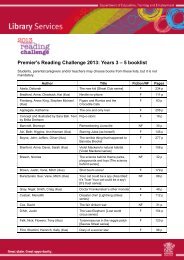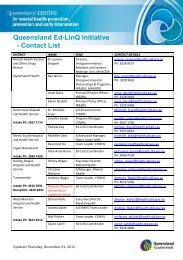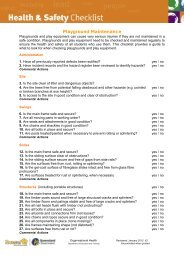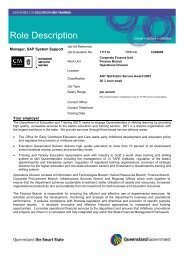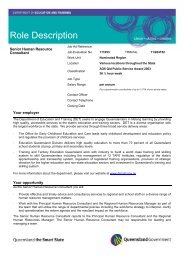Smart Choices - Healthy Food and Drink Supply Strategy for ...
Smart Choices - Healthy Food and Drink Supply Strategy for ...
Smart Choices - Healthy Food and Drink Supply Strategy for ...
Create successful ePaper yourself
Turn your PDF publications into a flip-book with our unique Google optimized e-Paper software.
Nutrient criteria to identify ‘Occasional’<br />
foods <strong>and</strong> drinks<br />
The ‘Occasional’ (RED) food <strong>and</strong><br />
drink criteria<br />
The tables on page 15 list a set of nutrient<br />
criteria <strong>for</strong> each category of food <strong>and</strong> drink<br />
that needs to be assessed. There are two main<br />
groupings:<br />
hot food items<br />
snack foods <strong>and</strong> drinks.<br />
Each category’s characteristics have been<br />
considered in the development of the criteria.<br />
Total fat <strong>and</strong> added sugar are not included<br />
in the criteria. By setting a limit on the total<br />
kilojoule content of the product, the amount<br />
of fat or sugar that can be added is restricted.<br />
Within the two main groupings of hot food<br />
items, <strong>and</strong> snack foods <strong>and</strong> drinks, there are a<br />
number of categories.<br />
Hot foods are assessed per 100 g due to<br />
the wide variation in serve sizes within this<br />
grouping.<br />
Snack foods <strong>and</strong> drinks are assessed ‘per<br />
serve’. The ‘per serve’ measure is provided<br />
<strong>for</strong> ease of use. It applies to those products<br />
that are generally pre-packaged into individual<br />
serves.<br />
Large serving sizes <strong>and</strong> excess intake of energy<br />
have been addressed by limiting the kilojoule<br />
content per serve of foods <strong>and</strong> drinks in the<br />
snack foods <strong>and</strong> drinks categories.<br />
Assessing a product against the<br />
criteria<br />
Use the ‘Occasional’ food <strong>and</strong> drink criteria<br />
table on page 15 to determine if a food or drink<br />
fits into the RED category of the spectrum.<br />
There are two examples on pages 17–18 to<br />
help you underst<strong>and</strong> how to use the Nutrition<br />
In<strong>for</strong>mation Panel on product labels to assess<br />
it against the nutrient criteria.<br />
The ‘Occasional’ food <strong>and</strong> drink<br />
criteria table<br />
If the hot food item you are considering<br />
has more than the number specified in the<br />
energy, saturated fat or sodium column it is an<br />
‘Occasional’ food <strong>and</strong> drink (RED category).<br />
If the snack food or drink product you are<br />
considering has more than the number<br />
specified in the energy, saturated fat or sodium<br />
column or less than the number in the fibre<br />
column, it is an ‘Occasional’ food or drink (RED<br />
category).<br />
The ‘Occasional’ (RED) food <strong>and</strong><br />
drink criteria tables<br />
Hot food items assessed per 100 g<br />
Category Nutrient Criteria<br />
<strong>Food</strong> or drink Energy (kilojoules) Saturated Fat (g) Sodium (mg)<br />
per 100 g<br />
per 100 g<br />
per 100 g<br />
Savoury pastries, pasta,<br />
pizzas, oven-baked<br />
potato products<br />
>1000 kJ >5 g >400 mg<br />
Crumbed <strong>and</strong> coated<br />
foods, frankfurters,<br />
sausages<br />
Snack foods <strong>and</strong> drinks assessed per serve<br />
Category Nutrient Criteria<br />
<strong>Food</strong> or drink Energy<br />
(kilojoules)<br />
per serve<br />
Sugar-sweetened drinks<br />
<strong>and</strong> ices*<br />
Snack food bars <strong>and</strong><br />
sweet biscuits<br />
Savoury snack foods<br />
<strong>and</strong> biscuits<br />
Ice creams <strong>and</strong> dairy<br />
desserts<br />
Cakes, muffins <strong>and</strong><br />
sweet pastries etc.<br />
>1000 kJ >5 g >700 mg<br />
Note: All DEEP-FRIED FOODS fit into the RED end of the spectrum <strong>and</strong> their supply should be limited in schools. They are<br />
too high in kilojoules <strong>and</strong> fat (usually saturated fat).<br />
Key: > means more than, < means less than.<br />
Saturated Fat<br />
(g) per serve<br />
14<br />
15<br />
Sodium<br />
(mg) per<br />
serve<br />
>300 kJ >100 mg<br />
Fibre<br />
(g) per serve<br />
>600 kJ >3 g 600 kJ >3 g >200 mg<br />
>600 kJ >3 g<br />
>900 kJ >3 g means more than, < means less than.<br />
Based on the NSW Department of Health <strong>and</strong> NSW Department of Education <strong>and</strong> Training Canteen Menu Planning Guide, 2004, which is<br />
part of the NSW <strong>Healthy</strong> School Canteen <strong>Strategy</strong>.



